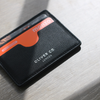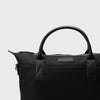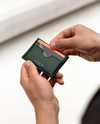SUSTAINABILITY
How we are transitioning to the Circular Economy

How we are transitioning to the Circular Economy
Within nature, there is no landfill. Everything is food for something else – a leaf that falls from the tree feeds the forest.
But humans have adopted a different process. We take, we make, and we dispose. Every time we do this, we eat into the world’s resources, often producing toxic waste that harms the environment. And since those resources are finite — as with oil, for example — this model simply cannot last.
To us, the solution is obvious: take nature’s lead, and move to a 'Circular Economy'.
Reading time: 7 mins
What is the Circular Economy?
Broadly speaking, the circular economy can be split into two categories.
Bio-cycle - creating products that after their useful life can be composted back into the soil, returning their nutrients, and in doing so helping to grow new resources that can be used again.
Technical cycle - creating products that after their useful life can be disassembled and up-cycled into new products, with no degradation in the materials’ performance.
In essence, the circular economy moves us away from ‘ownership’ of a product and towards something more like ‘leasing’. When you’re finished using something, you’d simply send it back to the manufacturer, who would either sort the materials into the bio-cycle, or enter them into the technical cycle, where those materials could be turned into new products.
If they’re designed perfectly, the loops within both the bio-cycle and technical cycle can be infinite, thereby producing no waste at all. The holy grail? Creating a technical-cycle material that, once it has fallen out of its upcycling loop, could simply degrade back into the earth.
So, how do we get there?
It involves challenging and changing an entire system, and it will take a lot of time and innovation to get there. But it’s a journey, and there are already many steps that companies such as ours can take to adopt circular principles. Steps we’re already taking to keep true to our mission of becoming the most sustainable accessories brand on the planet.
Here are some of the ways we are trying to move towards the circular economy...
OUR APPROACH
1. Keeping products out of Landfill for as long as possible
The design challenge of creating truly circular products is a difficult one. But whilst we develop and innovate with new fabrics, there’s one thing that brands can do immediately to help products stay out of landfill: make them last as long as possible. This means using high quality materials, durable craftsmanship, and partnering with a local repair scheme to mend any breakages.
The challenges
High quality labour, fabrics and components can result in product retail prices becoming out of reach for most consumers. Our approach? To sell direct to you, removing the middlemen associated with traditional retail, and selling high quality, design led products that last longer.
We’ve also teamed up with local craftspeople in London to be able to offer repairs where possible. As the company has grown we’ve come to learn that wallets can often be harder to mend and restore than other accessories like bags, however this is something we are addressing within our product development, making each product easier to disassemble and repair.
What comes next?
We see every product as a work in progress and we never stop improving. We continue to question every design decision down to the last stitch. How can we make each product wear better? What will be the first part to deteriorate?
It’s an iterative process between us, the manufacturer and, ultimately, you. We want to hear your feedback and to understand how the products change with time.
OUR APPROACH
2. Reducing our reliance on non-renewable & virgin materials
When we started Oliver Co. London in 2018, we began by looking at the way fabrics were evolving. We quickly recognised the shift away from an unsustainable reliance on fossil fuels and the devastating effects of the leather industry and wanted to be part of this change.
We left no stone unturned looking at the alternatives and their environmental benefits, but one stood out above the rest: apple leather.
Apple leather is a bio-based premium fabric made using apple waste from the Italian fruit juice industry, and combining it with polyurethane to create a soft, durable material.
The apple pomace used is a natural waste stream that would otherwise most likely be placed in landfill or burnt. Unlike other alternatives, apple leather doesn't require you to plant produce specifically for the leather production. And for us, there were further benefits; the apple farms were close to the fabric producer, and the material is OEKO-TEX certified, meaning it doesn’t contain any toxic materials.
Our manufacturer recently completed a life cycle assessment that compared a synthetic leather made with and without the apple waste. The diagram below shows the relative comparison, with the apple leather’s performance in green. The most notable reductions come in the Stratospheric ozone depletion, Land use and Marine eutrophication.
Where plastics are required in our linings (for durability and structure) we use only 100% recycled polyester. This not only helps keep polyester out of our landfills and our oceans, but it also reduces CO2 emissions by up to 29%, energy consumption by 44%, and water consumption by 16% compared to virgin polyester.
The challenges
As it currently stands, the addition of a plastic plays a pivotal role in the durability of bio-based leathers. Without it, the materials wouldn’t endure the general wear and tear of everyday life — and extending the life cycle of a product is an incredibly important aspect of sustainability.
You may have heard of grape leather, corn leather, pineapple leather, cactus leather or even mushroom leather. A small amount of plastic is required within all of these products. Plant-based polyurethanes are progressing, but these still contain 30% petroleum-based PU to ensure longevity and stability.
Plastics are also used in several other aspects of a small accessory’s production, such as glues, edge coats, linings and stitching. Looking specifically at stitching, a polyester thread is used within most accessories — including those made from genuine leather — as it’s very strong and glides a lot smoother, resulting in a longer lasting, better looking product. Linen threads are an alternative, but these can often fray and are difficult to work with.
What comes next?
We recently produced a sample using a new leather-like bio-material made entirely from natural inputs, with no added plastic. This is a big step within the industry and something we’re proud to be a part of.
We have also looked into the possibility of working with chemically engineered natural fibres. The closed-loop chemistry process enables naturally plentiful materials - like cotton and hemp - to take new shapes and perform at levels similar to synthetic fossil-fuel based counterparts, but from 100% natural sources. With this new technology we hope to create linings and threads with outstanding durability, that can still biodegrade after the product’s useful life.
We have also been working with polymer modified yarns which permit the acceleration of bacterial biodegradation in a controlled setting, speeding up what would be a 300-year cycle to one of less than four. As with the chemically engineered natural fibres, this means that when you return your Oliver Co. product back to us, we could disassemble and biodegrade more of the product and it’s nutrients to the earth.
All these products are still within early development, however we continue to develop samples and be at the forefront of innovation in the hope of bringing these products to market in the near future.
OUR APPROACH
3. Pushing Innovation: The Future of Design at Oliver Co.
Designing products for the technical cycle is all about keeping it simple: having the lowest possible diversity of ingredients to allow for easy recycling. It also means using clean materials that have been tested as having a positive impact on human health and the environment, and, where connections between materials are needed, are easily disconnecting at the end of each use phase.
Applying these principles to the construction of accessories — already a complicated process — meant rethinking the entire way we produce our products. But that’s what we’re here to do; to change the way the industry works, to push innovation forward, and be part of the solution.
For the past year and a half, we have been developing a new design. Made from renewable materials, it will be fully recyclable and won’t use glues, it can be made to order, and has the capability to be zero waste. If you would like to find out more about the project sign up to our newsletter, where we will be sharing what’s been going on behind the scenes in the coming months!
Along with you, we can make a difference. Follow us on Instagram to see how we’re working towards our circular goal.
If you would like to find out more about the Circular Economy we recommend checking out these:
Websites:
https://ellenmacarthurfoundation.org/
Books:
Cradle to Cradle by Michael Braungart and William McDonough
Waste to Wealth: The Circular Economy Advantage by Jakob Rutqvist and Peter Lacy
Instagram:
0 comments







